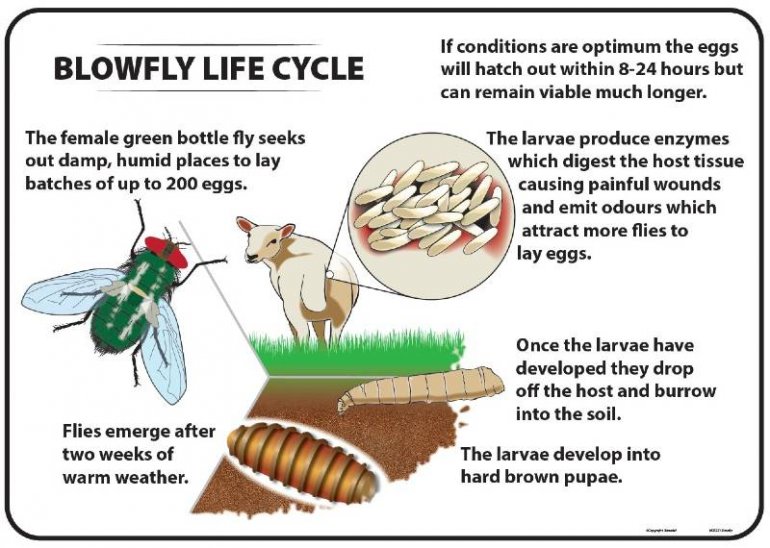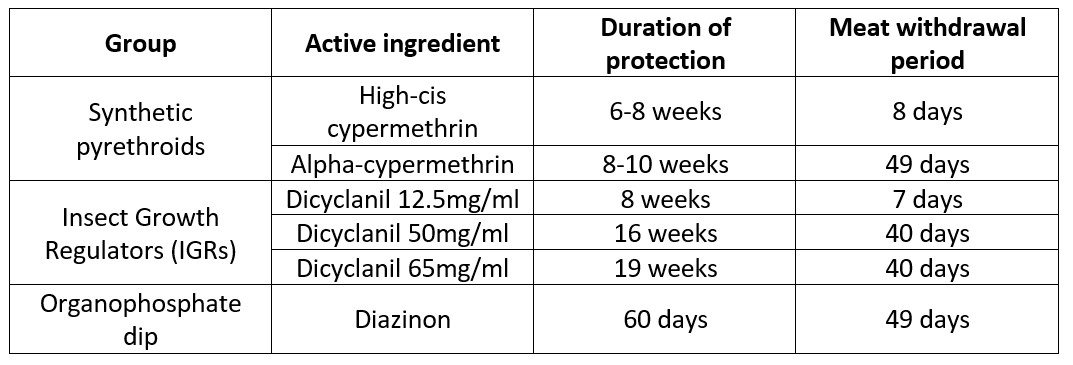Strike before you’re struck
Blowfly strike affects more than 75% of farms in the UK annually with an estimated 1.5% of ewes and 3% of lambs struck each year[1]. With changing weather patterns, the historical, more predictable summer fly season is a thing of the past and we now see more variation in the months which fly strike occurs, beginning as early as March and continuing until as late as December!
It is becoming increasingly difficult to manage as historical approaches to prevention based on specific timings, such as holding off until post shearing, are not always successful. Preventative action must now be strategic according to the risk and weather conditions.
Once laid, fly eggs can hatch into larvae (or maggots) within 8 hours if the conditions are right, and produce enzymes which digest the host tissue. This leads to skin damage, causing the painful wounds associated with strike. The maggots feed on dead and dying tissue and produce powerful odours which attracts other egg-laying females, rapidly increasing the severity of the situation.
If left untreated, the wounds will increase in size, become infected and ooze. This will cause the sheep to enter a state of shock and perish. This further complicates the situation as an undetected carcass would be an excellent host for more larvae to develop and thus increases the number of flies.
Risk Factors for Fly Strike:
Blowfly strike is multi-factorial with the following increasing the likelihood of strike:
Presence of organic matter in the fleece
Fleeces soiled with faeces or urine provide the perfect environment for fly strike and the presence of organic matter can reduce the efficacy of preventative products, leaving the animals at high risk.
Open wounds
This could be from footrot, a dagging injury or potentially even a previous fly strike wound. Even where preventative products have been applied, animals with open wounds are still susceptible to strike and need to be monitored more closely until the wound has healed completely.

Thick fleeces
Humidity is a key risk factor for strike and thick fleeces can create the perfect, humid micro-climate for maggot development.
Environmental conditions
Prolonged periods of hot weather can lead to an explosion in the fly population resulting in a very high challenge to livestock.
Prevention
Due to the multitude of factors which can predispose to fly strike, fly prevention products are only part of the solution, with other activities being critical to reduce the risk:
- Annual shearing and regular dagging/crutching of soiled fleeces. Shearing results in a 95% reduction in the incidence of strike[1].
- Docking - where appropriate, and when done in conjunction with the law. Docked lambs are 5 times less likely to suffer from fly strike.
- Check animals frequently during high-risk period.
- Remove any carcasses promptly.
- Reduce scouring (gastrointestinal parasite management, good nutrition).
- Any wounds should be monitored closely until resolved.
- Reduce the incidence of footrot.
Which Preventative Product is Right for my Flock?
There are a number of factors to consider when choosing a fly prevention product for your flock.
The withdrawal period and duration of action are important, particularly when drawing lambs for sale. Discuss treatment options with your vet or SQP, taking into account which other parasites can be targeted and the timing of treatment, to help decide which product is most appropriate for you.
Products available for blowfly prevention :
This newsletter content is provided by Bimeda, makers of Ectofly 12.5 mg/ml Pour-on Solution for sheep
Ectofly is a POM-VPS medicine licenced for the treatment and control of headflies, and treatment of tick infestation and biting lice and prevention and treatment of blowfly strike in sheep. It contains 12.5mg/ml high-cis cypermethrin. For further information see the SPC available on the VMD website. Advice should be sought from the prescriber. Further information available from Bimeda UK, https://www.bimeda.co.uk/ +44 (0)1248 725 400. Use Medicines Responsibly- Noah.co.uk/responsible
References
[1] Lihou, K., & Wall, R. (2019). Sheep blowfly strike: the cost of control in relation to risk. animal. https://doi.org/10.1017/S1751731119000831
[2] https://bvajournals.onlinelibrary.wiley.com/doi/10.1136/inp.h1434
[3] Note: deltamethrin has not been included as it is only licenced for the treatment of established strike (maggots) but not for the prevention of strike.
- 3rd July 2023

